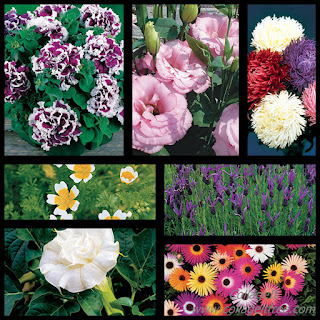- by Debra Anchors
 |
| Collage of Annuals |
Annuals are superb problem solvers. As most experienced gardeners will attest, annual plantings are unequaled for providing affordable color -
filling gaps, extending the garden’s bloom, and providing a seemingly endless supply of cut flowers.
If you are willing to start from seed, annuals offer a very economical way to fill the garden with color. Even if your landscaping budget is limited, you can still afford almost instant gratification if you plant your designs initially in annuals. To give the garden permanence,
phase in perennials as you can afford them.
Direct sown vs. transplants
The selection of annuals you’ll find as garden-ready transplants at your nursery is plentiful. But, to gain access to the full diversity of annual flowers, you must be willing to start plants from seed yourself.
Typically, this is done in one of two ways – by sowing seeds indoors on a sunny windowsill, or by sowing the seeds directly into garden beds. Indoor sowing is popular in the North because it gives the gardener a head start on spring. Direct sowing, however, is less work and produces just as good a display – especially where the growing season is long, as in the South. Many kinds of annuals may be started by either method. Some species, though, only respond to one kind of planting method. Snapdragon and petunia seeds, as examples, are so tiny that they are liable to wash away if sown outdoors and are therefore routinely started indoors. And, ageratum seedlings are so delicate that they do not cope well with the stress of an outdoor nursery. Iceland poppies have extra-sensitive roots that seldom tolerate the disturbance of transplanting. Although occasionally started in peat pots indoors, poppies generally grow better when direct sown.
A Brief List of Annuals to Direct Sow
|
Annuals Best Started Indoors
|
|
|
Baby’s breath
|
Ageratum
|
California poppy
|
Coleus
|
Feverfew
|
Flowering tobacco
|
Giant sunflower
|
Heliotrope
|
Godetia
|
Hybrid verbena
|
Iceland poppy
|
Impatients
|
Larkspur
|
Lobelia
|
Love-in-a-mist
|
Petunia
|
Nasturtium
|
Snapdragon
|
Opium poppy
|
Spider flower
|
Pot marigold
|
Zonal geranium
|
Scarlet runner bean
|
|
Sweet alyssum
|
|
Wind poppy
|
|
Annuals are genetically predisposed to stop flowering as soon as they have set seeds. To keep your display in bloom, you must pinch or snip off all the aging flowers as they start to fade.
The limited life span of annuals is a great advantage when it comes to pest control. Perennials can develop fixed pest populations that overwinter and then reappear each year with the plant. By varying the kinds of annuals you plant in any given spot each year, you ensure that your floral display never develops a similar problem.
If you enjoy this website, you might like my magazine,
Gardening Life.
Thank you for stopping by to spend time in
my garden. If you liked the article, please take a moment to let me know. I will be delighted if you would suggest Gardens Inspired to your friends, follow me or subscribe to my Blog.
Leave a legacy, but garden like you’ll live forever!
-Debra
Did you like this post? Please recommend it to other readers by selecting the
g+1 box, below.









